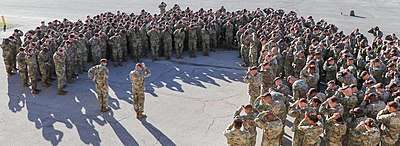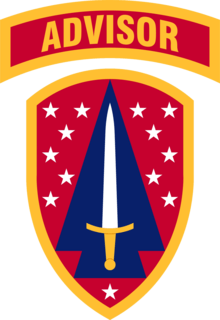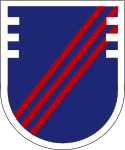3rd Security Force Assistance Brigade
The 3rd Security Force Assistance Brigade (3rd SFAB) is a Security force assistance brigade of the United States Army. It is based in Fort Hood, Texas.[1] 3rd SFAB will relieve 2nd SFAB in Afghanistan for the Winter 2019 rotation.[2]
 Advisors from the 3rd Security Force Assistance Brigade don their brown berets at a ceremony standing up the unit |
| 3rd Security Force Assistance Brigade | |
|---|---|
 The SFAB's shoulder sleeve insignia | |
| Founded | January 2019–present |
| Country | |
| Branch | |
| Type | Military education and training |
| Role | Train and advise foreign militaries |
| Garrison/HQ | Fort Hood, Texas, U.S. |
| Color of berets | Brown |
| Commanders | |
| Current commander | BG Charles Masaracchia |
| Command Sergeant Major | CSM Raymond S. Harris |
| Insignia | |
| Distinctive unit insignia |  |
| Beret flash |  |
Security Force Assistance Brigades
SFABs are brigades whose mission is to train, advise, and assist (TAA) the armed forces of other states. Operationally, an 800-soldier SFAB would free-up a 4,500-soldier BCT from a TAA mission.
On 23 June 2016 General Mark Milley revealed plans for train/advise/assist Brigades, consisting of seasoned officers and NCOs with a full chain of command, but no junior Soldiers.[3] The SFABs were to consist of 800 senior officers and NCOs, which, the Army says, could act as a cadre to reform a full brigade combat team in a matter of months.[4] In May 2017, the initial SFAB staffing of 529 soldiers was underway, including 360 officers. The officers will have had previous command experience.[3]:21:20 Commanders and leaders will have previously led BCTs at the same echelon.[5] The remaining personnel, all senior NCOs, are being recruited from across the Army.[6][7][8] Promotable E-4s who volunteer for the SFAB are automatically promoted to Sergeant upon completion of the Military Advisor Training Academy.[9] In the event of a national emergency SFABs could be augmented with new soldiers entering basic training and advanced individual training.[3]
On 16 October 2017, BG Brian Mennes of Force Management in the Army's G3/5/7 announced accelerated deployment of the first two SFABs, possibly by Spring 2018 to Aghanistan and Iraq, if required.[10] This was approved in early July 2017, by the Secretary of Defense and the Chief of Staff of the Army. These two SFABs would be trained in languages, how to work with interpreters, and equipped with the latest equipment including secure, but unclassified, communications and weapons to support coalition partners,[11][12][10] as well as unmanned aircraft systems (UASs).[13] An SFAB could provide up to 58 teams (possibly with additional Soldiers for force protection).[10]
A team of twelve soldiers would include a medic, personnel for intelligence support, and air support.[14]
References
- Myers, Meghann (2018-05-21). "These three posts will be home to the Army's next security force assistance brigades". Army Times. Retrieved 2018-09-06.
- U.S. Army Public Affairs (August 16, 2019) Army announces upcoming 3rd Security Force Assistance Brigade unit rotation
- Priorities for Our Nation's Army with General Mark A. Milley (23 June 2016):Minute 18:40/1:00:45
- "CSA explains how skeletal advisory brigades could regenerate force". Retrieved 19 October 2016.
- (16 October 2017) First security force assistance brigade training for deployment
- Lolita C. Baldor (4 May 2017) Associated Press Uncle Sam: We want you... to train others! $5K bonus offered accessdate=2017-05-05
- Security force assistance brigades to free Brigade combat teams from advise, assist mission
- Army Moves Closer to Establishing First Security Force Assistance Brigade
- 1st SFAB promotes first Soldiers to sergeant under new policy
- AUSA (16 October 2017) AUSA Video clip, Warriors corner #9: All things Security Force Assistance Brigade (SFAB), part of the article, "First security force assistance brigade training for deployment"
- Capt. John May (November 27, 2017) Military Advisor Training Academy prepares 1st SFAB as combat advisors
- (December 21, 2017) Equipping SFABs: A 'Rubik's Cube' of logistics over 5,000 pieces of equipment
- (6 December 2017) Eyes in the Sky with 1st SFAB
- Jaffe and Ryan (21 January 2018), Washington Post Up to 1,000 more U.S. troops could be headed to Afghanistan this spring